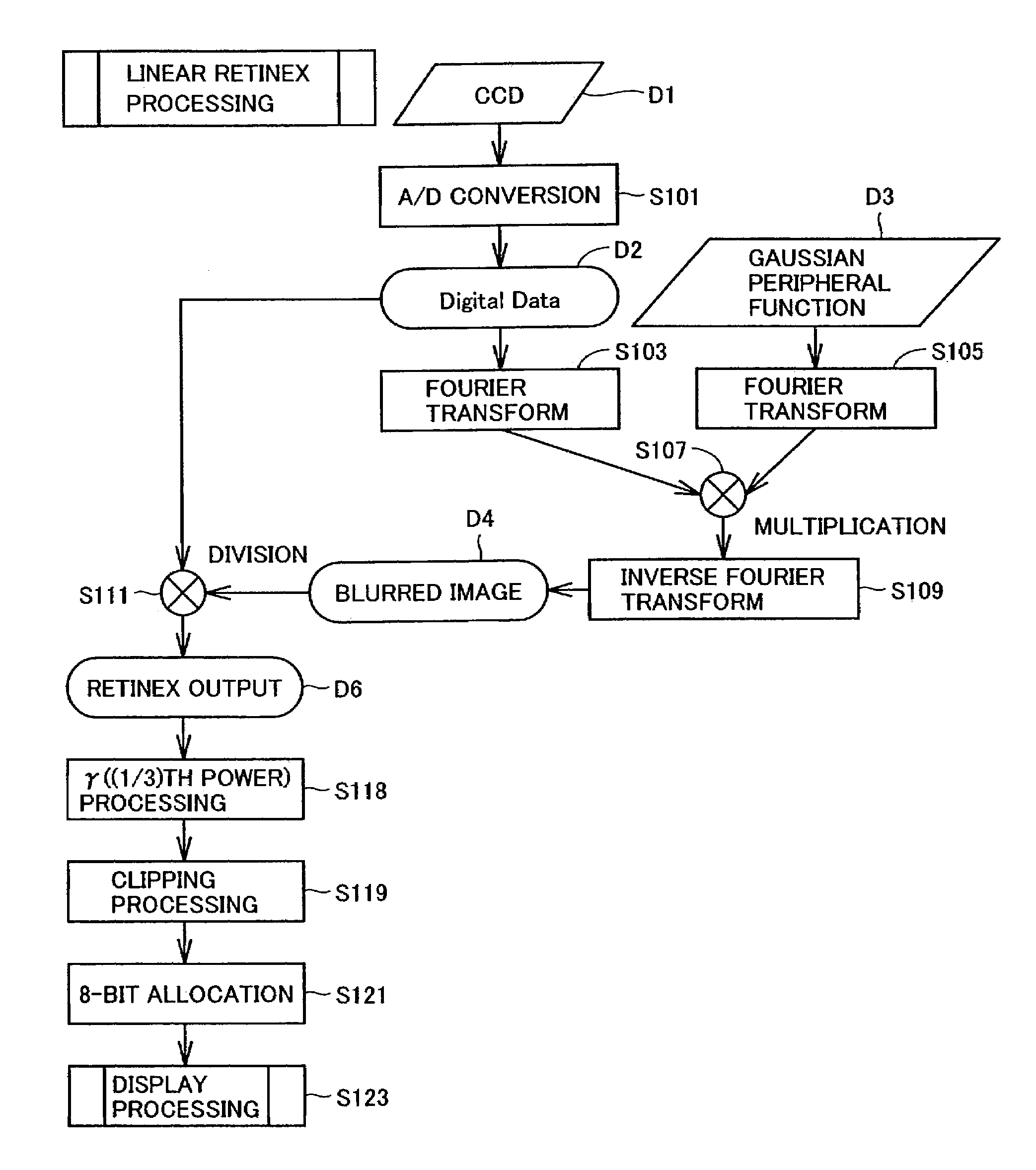Image processing program product and device for executing Retinex processing
a technology of image processing and program product, applied in image enhancement, image analysis, instruments, etc., can solve the problems of reducing processing speed, increasing memory consumption, and heavy calculation processing for producing blurred images
- Summary
- Abstract
- Description
- Claims
- Application Information
AI Technical Summary
Benefits of technology
Problems solved by technology
Method used
Image
Examples
first embodiment
[0070]FIG. 1 is a block diagram showing a structure of an image pickup apparatus performing Retinex processing in a first embodiment. In FIG. 1, arrows indicate flows of image data.
[0071]Referring to FIG. 1, an image pickup apparatus includes a CCD image sensor 101 serving as an image pickup device, an A / D converter 102, a Retinex processing portion 103, a gamma correcting portion 104 and a display / save portion 105.
[0072]CCD image sensor 101 produces analog signals R, G and B (i.e., electric signals) from incident light by a photoelectric conversion. A / D converter 102 converts analog signals R, G and B into discrete digital signals R, G and B, e.g., of eight bits. Retinex processing portion 103 conducts the Retinex processing such as SSR or MSR on digital image signals, which are subjected only to the A / D conversion by A / D converter 102, and particularly on each of R, G and B channels independently of each other.
[0073]Gamma correcting portion 104 performs predetermined gamma correct...
second embodiment
[0081]FIG. 2 is a block diagram showing a structure of an image pickup apparatus performing Retinex processing in a second embodiment.
[0082]In this embodiment, Retinex processing portion 103 performs linear Retinex processing. The linear Retinex processing is Retinex processing not using a logarithm, and is executed with a ratio between an original image and a blurred image expressed by the following formula (5).
Ti(x, y)=Ii(x, y) / {F(x, y)*Ii(x, y)} (5)
(i=R, G,B)
where “*” represents a convolution integral, similarly to the formula (1). Ti(x, y) represents a pixel value after the linear Retinex processing, and Ii(x, y) represents a pixel value of an original image. F(x, y) is, e.g., a Gaussian function for producing a blurred image satisfying the foregoing formulas (2) and (3).
[0083]The linear Retinex processing may be likewise executed by MSR.
[0084]Further, Retinex processing portion 103 may perform the processing (gamma correction) of obtaining a (1 / γ)th power Ti(x, y), as expresse...
third embodiment
[0088]FIG. 3 is a block diagram showing a structure of an image pickup apparatus performing the Retinex processing in a third embodiment.
[0089]In this embodiment, Retinex processing portion 103 shown in FIG. 2 performs the linear Retinex processing, and then gamma correcting portion 104 performs the gamma correction for the device. Thereby, the gamma correction can be performed in accordance with the device. Thus, the gamma correction can be performed only by gamma correcting portion 104. Alternatively, processing may be performed in such a manner that Retinex processing portion 103 performs the gamma correction with γ=3 for providing the output having linear characteristics with respect to the brightness as described above, and gamma correcting portion 104 performs the correction in accordance with the device.
PUM
 Login to View More
Login to View More Abstract
Description
Claims
Application Information
 Login to View More
Login to View More - R&D
- Intellectual Property
- Life Sciences
- Materials
- Tech Scout
- Unparalleled Data Quality
- Higher Quality Content
- 60% Fewer Hallucinations
Browse by: Latest US Patents, China's latest patents, Technical Efficacy Thesaurus, Application Domain, Technology Topic, Popular Technical Reports.
© 2025 PatSnap. All rights reserved.Legal|Privacy policy|Modern Slavery Act Transparency Statement|Sitemap|About US| Contact US: help@patsnap.com



